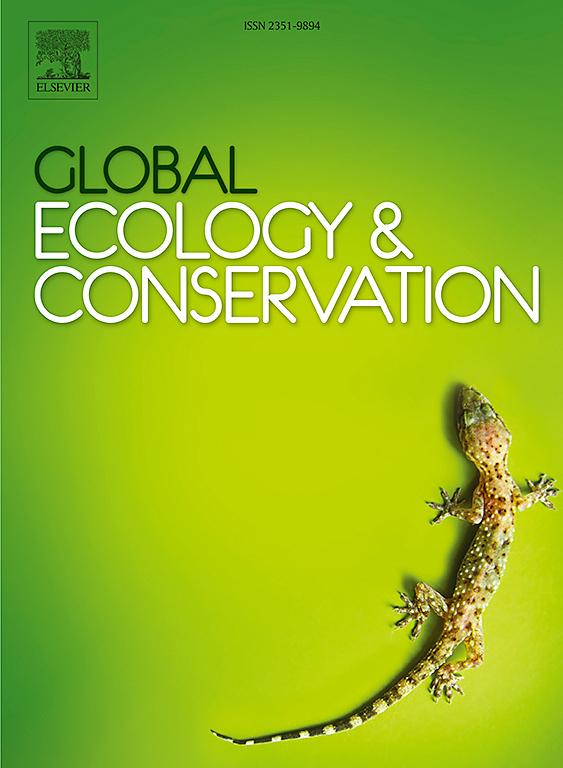Seasonal waterbird distribution patterns vary in response to current shellfish aquaculture and areas suitable for future development in Rhode Island USA
IF 3.5
2区 环境科学与生态学
Q1 BIODIVERSITY CONSERVATION
引用次数: 0
Abstract
Marine aquaculture is globally widespread and supplies most of the world's shellfish. In the United States, shellfish aquaculture spans all coastlines, with states like Rhode Island experiencing recent substantial increases in aquaculture. Rhode Island’s marine ecosystem supports numerous migratory waterbird species, and the expansion of shellfish aquaculture has the potential to directly impact the distribution of these species. We used land-based survey data to assess whether and how distance to shellfish aquaculture affects seasonal waterbird distribution patterns and identify species most and least likely to be impacted by future aquaculture development. We conducted a total of 3698 surveys across 54 study sites from 2020─2023 and fit monthly generalized additive mixed models to predict waterbird distributions for 29 species. For most waterbird species, distance to aquaculture explained little to no spatial variation in their monthly distribution patterns; indicating other resource layers were more informative. Dabbling ducks often favored closer proximity to aquaculture, while sea ducks, mergansers, gulls, and terns showed species-specific preferences, and herons and egrets consistently favored shallower waters. Using model-derived distributions, we found that ∼28 % of species preferred areas better suited for future aquaculture development, while ∼10 % favored areas poorly suited. Our research provides valuable insights into the factors driving waterbird distributions, particularly in relation to their proximity to current shellfish aquaculture. Our findings suggest that although current aquaculture operations are not having substantial impacts on species distribution patterns, future development will likely conflict with species favoring shallow waters, as these areas are also most suitable for aquaculture expansion.
在美国罗德岛,季节性水鸟分布模式因当前贝类养殖和适合未来发展的地区而异
海洋水产养殖在全球范围内广泛存在,并供应世界上大部分贝类。在美国,贝类养殖业遍布所有海岸线,罗德岛等州最近的水产养殖业大幅增长。罗德岛的海洋生态系统支持着许多迁徙的水鸟物种,而贝类养殖业的扩张有可能直接影响这些物种的分布。我们利用陆基调查数据来评估与贝类养殖的距离是否以及如何影响季节性水鸟分布模式,并确定最可能和最不可能受到未来水产养殖发展影响的物种。从2020年到2023年,我们在54个研究地点共进行了3698次调查,并拟合每月广义加性混合模型来预测29种水鸟的分布。对大多数水鸟物种来说,距离养殖场的距离对其月分布格局的空间变化几乎没有解释;表明其他资源层的信息更丰富。涉水鸭通常更喜欢靠近水产养殖的地方,而海鸭、秋沙鸭、海鸥和燕鸥则表现出特定的物种偏好,苍鹭和白鹭一直喜欢较浅的水域。利用模型推导的分布,我们发现~ 28% %的物种更喜欢适合未来水产养殖发展的地区,而~ 10% %的物种更喜欢不适合的地区。我们的研究为推动水鸟分布的因素提供了有价值的见解,特别是与它们与当前贝类水产养殖的接近有关。我们的研究结果表明,尽管目前的水产养殖活动对物种分布格局没有实质性影响,但未来的发展可能会与偏好浅水的物种发生冲突,因为这些地区也最适合水产养殖扩张。
本文章由计算机程序翻译,如有差异,请以英文原文为准。
求助全文
约1分钟内获得全文
求助全文
来源期刊

Global Ecology and Conservation
Agricultural and Biological Sciences-Ecology, Evolution, Behavior and Systematics
CiteScore
8.10
自引率
5.00%
发文量
346
审稿时长
83 days
期刊介绍:
Global Ecology and Conservation is a peer-reviewed, open-access journal covering all sub-disciplines of ecological and conservation science: from theory to practice, from molecules to ecosystems, from regional to global. The fields covered include: organismal, population, community, and ecosystem ecology; physiological, evolutionary, and behavioral ecology; and conservation science.
 求助内容:
求助内容: 应助结果提醒方式:
应助结果提醒方式:


